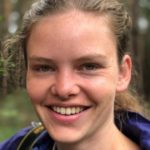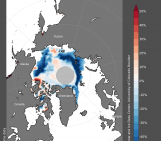
Light emissions are increasing worldwide and much of the world is light polluted due to excessive and inefficient light use. This has negative consequences for many organisms, such as birds, insects, fish, plants and humans. Even in the high Arctic, which is remote and sparsely populated, and experiences the polar night for a large part of the year, there are artificial light sources which disturb organisms, especially those that are adapted to the low light conditions. And with climate change, these effects might be amplified.
Worldwide light pollution
When your neighbor’s flood light makes it difficult for you to sleep at night, when you can’t see the stars because of skyglow, or when insects gather around light sources instead of mating and pollinating plants – these are all excellent examples of light pollution. According to the new world atlas of artificial night sky brightness by Falchi et al. (2016), 99% of the populations in Europe and the U.S. live under light-polluted skies. Light pollution has severe consequences for many organisms and ecosystems. Take for example birds, which I love and wrote about in this previous blog. Many bird species migrate between breeding and wintering grounds, and many migratory birds fly at night. On nights with bad weather, many birds fly low and are attracted, distracted and disoriented by artificial light at night. They often fly into cities, where they are subject to many risks such as flying against buildings, often with fatal consequences. Most organisms have adapted to day and night cycles and, believe it or not, 30% of vertebrates and >60% of invertebrates are actually nocturnal! What happens to them when the nights disappear?
Natural light sources in the Arctic
The polar regions have a unique solar cycle with uninterrupted daylight for several months during summer as a result of the midnight sun, as well as comparatively periods of darkness during the winter season. But when sunlight is lacking during the long period of darkness in winter, does it mean it is completely dark? No! You must have heard of or maybe seen the spectacular light shows of the aurora borealis or polar lights. These also show up on radiance measurements by satellites (see image below). Many organisms have adapted to the lunar cycle. For example, we now know that during the Arctic winter, moonlight drives zooplankton migrations. Not without difficulty (see next section “Arctic light pollution”), marine biologists measured the amount of light and the biota’s ability to detect it (Cohen et al., 2022), and found that the organisms’ biological clocks continued to be synchronized with the sun, even when the sun retreated below the horizon for months on end. Where it was long thought that the high Arctic was practically asleep during the polar night, they showed there is way more going on than we originally thought.
In the Arctic Ocean, light also results from bioluminescence (not classified as pollution): chemically-generated light by organisms, produced by dinoflagellates, crustaceans, algae, worms, fish, microbes and many other organisms in the water column. This light might help predators to find their prey, or it may help prey to see when predators are coming. Hotspots of luminescence activity can even be seen using nighttime satellite images. Swimming organisms or ships can also mechanically disturb luminescent organisms, leaving traces on the dark surfaces of the ocean (Eklöf, 2022).

Light pollution in North-America. The green areas in the North are due to a ring of auroral light. Map created with lightpollutionmap.info. Overlay: Visible Infrared Imaging Radiometer Suite (VIIRS) 2022, data courtesy of Earth Observation Group, NOAA National Geophysical Data Center. Base map: Microsoft Bing road base layer.
Arctic light pollution
Artificial light has a strong impact across the world, but especially so in low-light environments, such as the polar regions. In the Arctic, artificial light sources include human settlements, oil and gas rigs and refineries (see image below), and air and sea ports. Additionally, snow and cloud cover can further brighten the environment by reflecting artificial light, extending the area that is illuminated. To monitor artificial light sources is not easy. Satellites only take a snapshot of specific areas at specific points in time, often early in the morning, thereby missing the main period of light use in the evening for lower latitudes, or during the entire day in the higher latitudes (Arctic). Furthermore, previous remote sensing studies of artificial light sources in the Arctic (Beamish et al., 2020; Bennett and Smith, 2017), concluded that a big challenge with observing (artificial) light in the Arctic from space is the dramatic variability in atmospheric aurora and surface albedo. In-situ light measurements, as by the above-mentioned Cohen et al. (2022), are difficult as a lot of sensors available are not suitable in the low light conditions of the polar night.
How are polar night adapted organisms affected by artificial light pollution?
In general, the majority of studies investigating biological responses to artificial light show negative consequences for organisms. Ludvigsen et al. (2018) demonstrated that zooplankton moved away from the artificial light from large research vessels down to more than 80-m depth. Other studies showed a similar negative effect on krill as well as negative effects on fish. And these effects don’t stop at the ocean-land interface. Reindeer exposed to artificial light were shown to have a changed light sensitivity of their eyes. Under natural light conditions, reindeer change their eye structure between the summer and winter, turning from golden in summer to blue in winter. This is the result of adaptation of the tapetum lucidum, the reflective surface behind the central retina, to the low light conditions in winter to make it easier to find food and detect predators. But under artificial light conditions, the reindeer’s tapetum lucidum turns a shade of green, basically between the summer golden and winter blue. These examples show that not only the orientation, navigation and foraging behavior of Arctic animals is influenced by artificial light during the polar night, but also their seasonal biology. A lot is still unsure about how organisms perceive light and how increased light availability following less or thinner sea ice might impact biota.

Light pollution in the Yamal Peninsula, Russia. Map created with lightpollutionmap.info. Overlay: World Atlas 2015. Base map: Microsoft Bing road base layer.
Climate change increases light pollution in the Arctic
Light pollution as a result of Arctic warming may pose a new threat to marine life. Today, a significant proportion of vessel operations take place in or through the Arctic, with 5,000 vessels making a total of more than 130,000 trips between 2015 and 2017. Climate change results in the reduction of the sea-ice cover, which opens up new routes for shipping and locations for extraction of resources. It was predicted that trans-Arctic shipping may even be possible in 30 years. This will lead to increased risks following light pollution for organisms living in the high Arctic.
Understanding light use and how to make a change
Light pollution is everywhere. Global light emissions are increasing every year and we don’t understand why. Are there more light sources or brighter ones? What kind of lights are turned on when, where and why? How can we do better and make our lights more effective (i.e. decrease light pollution)? The International Dark Sky Association, as the overarching international authority addressing light pollution, recommends to use lights only where and when needed, to use the lowest light level required and to avoid shorter wavelength (e.g. blue) light (check out their 5 principles for effective light use). First, public awareness of light pollution in general needs to be raised, it should be acknowledged that light pollution poses a biodiversity threat, and regulations for effective light use should be put into place. A good example was set by Wren and Locke (2015). Their work on how more effective light use on oil rigs could increase visibility for workers, led to a series of recommendations for light use on oil and gas infrastructure. Then, we need to apply this in the Arctic and make sure that even with increasing traffic and extraction of resources, man-made light pollution in the Arctic is similarly limited.
Want to learn more about light pollution? In our citizen science project Nightlights, citizen scientists and researchers work together to map and count light sources using the Nightlights App in Germany and worldwide. You can participate and help count light sources this fall (September-October 2023)!
Further reading
- Check out light pollution around the world with the lightpollutionmap
- Citizen science project Nightlights
- book by Eklöf, J. (2022). The Darkness Manifesto: How light pollution threatens the ancient rhythms of life. Random House.
- article about light pollution
- article about sky brightness levels before and after the creation of the first International Dark Sky Reserve
- article about the impact of light pollution on birds
Edited by Tun Jan Young and Lina Madaj
 Loeka Jongejans worked on Arctic permafrost sediments and the impact of permafrost thaw on stored carbon during her PhD at the Alfred-Wegener-Institute. Now, as a Postdoc at the Ruhr-University Bochum, she is working on the citizen science project Nightlights, where citizen scientists and researchers work together to map and count light sources using the Nightlights App in Germany and worldwide. Loeka tweets as @JongejansLoeka. E-Mail: loeka.jongejans@ruhr-uni-bochum.de
Loeka Jongejans worked on Arctic permafrost sediments and the impact of permafrost thaw on stored carbon during her PhD at the Alfred-Wegener-Institute. Now, as a Postdoc at the Ruhr-University Bochum, she is working on the citizen science project Nightlights, where citizen scientists and researchers work together to map and count light sources using the Nightlights App in Germany and worldwide. Loeka tweets as @JongejansLoeka. E-Mail: loeka.jongejans@ruhr-uni-bochum.de




